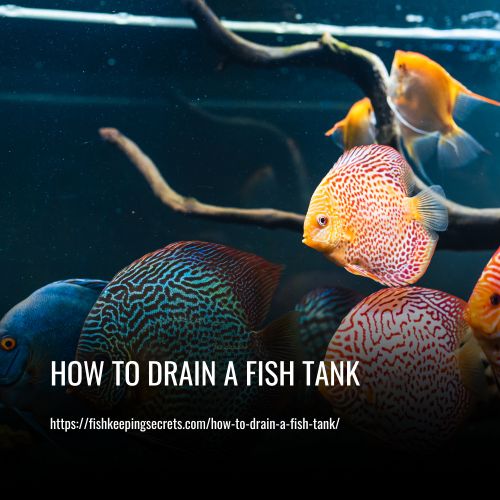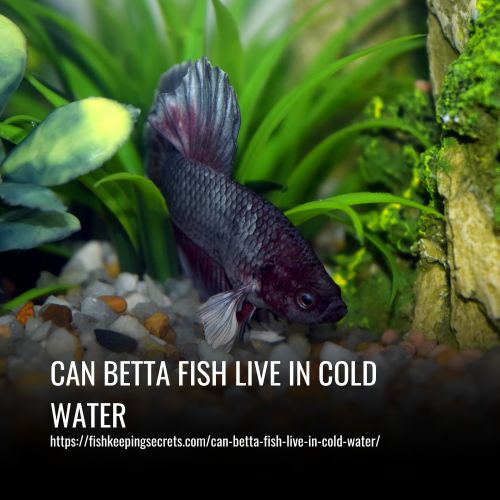Draining a fish tank may seem like a simple task, but there are certain steps and precautions to take to ensure the safety of the fish and the tank itself.
To Drain A Fish Tank, Follow These Steps:
- Clean Your Water Changer
- Attaching Your Water Changer to Your Faucet
- Draining Your Aquarium
- Adding the Water Conditioner
- Refilling Your Aquarium
- Packing Away Your Water Changer

How to Drain a Fish Tank In Simple Steps
Whether you’re a beginner or experienced fish owner, knowing the proper way to drain your tank is essential for maintaining a healthy aquatic environment for your fish. Here we will discuss the steps and techniques for safely and effectively draining a fish tank.
1. Clean Your Water Changer
Cleaning your water changer is essential when it comes to draining your fish tank. Whether you’re using a new one you bought or borrowing someone else’s, it should always be properly cleaned before use. This helps to get rid of dust, oils, and other gunk which can end up in your tank otherwise.
To do this, simply fill a bucket with dechlorinated water and run it through the water changer – just don’t forget to use a water conditioner! The gravel tube should be rinsed and the outer surface of the short length that fits inside the aquarium should be cleaned. The hosing outside your tank does not need to be cleaned as it will not come into contact with any of your fish.
It may seem like an unnecessary step at first but when it comes to draining your fish tank successfully and safely, cleaning your water changer is vital.
2. Attaching Your Water Changer to Your Faucet
Attaching your water changer to your faucet is a crucial step in draining your fish tank. It comes with a threaded fitting, that you can attach directly to most home faucets; however, some faucets come in different shapes and sizes and the adapter might not fit.
In order to connect with your inconsistent size faucet, you might need to remove the small screen on the end of it known as an “aerator.” This should easily screw off using just a wrench. Once removed, take the adapter that came in the packaging of your water changer and screw it into the faucet.
If the adapter still won’t fit, then go ahead and make that quick trip to the home depot or plumbing supply store. Buy an extra adapter so you can be sure that everything connects up properly for maximum efficiency when trying to drain your fish tank!
3. Draining Your Aquarium
Draining your fish tank doesn’t have to be a difficult task. With the help of a water changer, it can be a quick and easy process. Instead of using power for suction like some gravel vacuums, water changers rely on gravity and the pressure of running tap water.
Simply attach the water changer hose to your faucet securely with its sturdy connection, place the end into your aquarium, and turn on the faucet gently. The higher you turn up the faucet, the stronger the suction will be, allowing you to empty your aquarium more quicker.
Water changes also come equipped with a gravel tube at the end that makes it easier for you to clean out any debris from your fish tank’s substrate if you choose. When you’re finished draining, simply lift up out of your tank and turn off the faucet at the sink side.
4. Adding the Water Conditioner
Once you have drained your fish tank to your desired level, the next step is to add a water conditioner. Water conditioners are essential as they work to remove toxins, such as chlorine and heavy metals, from tap water that can be harmful to your fish.
The best way to add a water conditioner is by using an aquarium dosing pump. With the dosing pump, all you have to do is set it up on the edge of the tank and let it automatically release the right amount of water conditioner into your aquarium according to its instructions. This will ensure that your fish are safe and healthy.
When Do You Add the Water Conditioner?
One of the most important things to consider when draining your fish tank is when you should add the water conditioner. It is recommended to add a water conditioner to a bucket of water before transferring it to an aquarium. But if you use a water changer that delivers tap water directly from your faucet, it may be difficult to do this.
Although some water changers claim that aerating the refilling process can eliminate some of the chlorine from the tap water, this is not always true and it does not make it safe to add to your aquarium. Therefore, it is recommended that you add the water conditioner during the refilling process – slowly dripping it in as water streams from the water changer for maximum effect.
This way, you are sure to keep your fish tank at safe levels without having to take an extra step or introduce any unwanted chemicals into your tank!
5. Refilling Your Aquarium
Refilling your aquarium with fresh water is the last step after completing all the necessary preparation. To do this properly and avoid flooding your tank, it is important to avoid excess flow when turning on the water. Make sure you turn off your water changer if it has an on/off switch.
When at the sink, adjust the flow valve so that the stream is directed up through the housing and into your tank. Depending on how high up your tank is located, you may have to experiment with different intensities of steam pressure in order to make sure that it flows adequately into the tank. When you are ready, slowly turn on the switch and let the water pour in while pouring the conditioner along with it. Once your tank’s full, turn off both the switch and faucet to finish filling up!
6. Packing Away Your Water Changer
Packing away your water changer is an essential part of refilling your aquarium. To ensure the safety of those around you and to minimize the risk of tripping over your equipment, you should pack it away after each use.
Adjust the flow control valve on your faucet to enable draining, and then coil up the tubing from its end at the aquarium. As you do so, any remaining water will be directed to the sink through the faucet. When all is said and done, remove the adapter from your faucet and replace any aerators. Tuck away your water changer until next time!
Why and How Do I Need To to Get Water Out of Fish Tank
If you want to maintain a healthy balance in your fish tank, regular water changes are essential. By draining a portion of the water out of your tank and replacing it with clean, fresh water, you’ll be able to keep the contents clean and balanced.
The exact amount of water that should be changed varies depending on the specific situation. As a general rule, it’s recommended to change out at least 20% of the total volume every week, though this can be increased if necessary. For more serious circumstances—such as an algae bloom or disease outbreak—it may even be necessary to completely empty all of your water out and start from scratch.
Draining water from your tank also helps reduce nitrification caused by debris buildup, which is important for achieving a thriving ecosystem balance that will benefit your fish. The University of Arizona even states that not effectively removing waste from the culture water will prevent you from producing fish efficiently.
How To Properly Refill The Fish Tank After Draining It
When it’s time to refill your fish tank after draining it, you first need to add your substrate back to the bottom. And don’t forget about replanting any live or artificial plants, making sure that all of them stay wet during the process. Refilling a depleted aquarium can be achieved with a garden hose or siphon hose for maximum efficiency. If none of those are available, a bucket can be used as an alternative but it will require more effort; repeated trips, and a physical workout.
Adding water conditioner at the start or end of the process will help detoxify chlorine, chloramine, and heavy metals so it’s important not to leave this step out. If there are live plants in the tank, dechlorinating at the start is best as chlorine isn’t good for them. Once everything is filled up you can turn on the heater and get the water temperature close to ideal before adding anything else. Then plug in any aquarium lights and filters as well before introducing your fish into their new home.
FAQs
I generally do not suggest entirely emptying a fish tank unless the intent is to store it away. This is because it can be very stressful for the fish, and beneficial bacteria and plants generally benefit from the organic matter that builds up in the tank. For regular cleaning, weekly water changes are recommended.
The size and number of the fish in the tank should be considered when deciding whether to drain it or to take the fish out beforehand. If it is a small tank, it is best to take out the fish as it would not take long to catch them. Furthermore, there is a risk of them being sucked up into the siphon hose, although unlikely to cause injury, this could still potentially harm them.
It is recommended to perform a partial water change and drainage of your fish tank every 1-2 weeks, depending on the size of your tank and the number of fish. This will help maintain a healthy environment for your fish by removing waste and replenishing clean water.
For a partial water change, it is best to remove and replace about 20-25% of the water in your fish tank. This will help maintain the balance of healthy bacteria and nutrients in the water while also removing waste and contaminants.
It is best to dispose of the drained water from your fish tank by either using it to water your plants or by safely emptying it down a drain. Avoid dumping it into natural bodies of water to prevent contamination.
While draining your fish tank, it is a good opportunity to clean and inspect any equipment, such as filters and heaters, to ensure they are functioning properly and to remove any built-up debris or waste.
To drain your fish tank without harming your fish, use a gravel vacuum to remove water while also vacuuming the gravel to remove debris. This will prevent your fish from being stressed or harmed by sudden changes in water levels or contaminants.
While draining the tank, you can use the opportunity to clean any algae or debris from the glass, decorations, and gravel. However, be cautious not to disturb the beneficial bacteria in the tank’s biological filtration system.
Before adding new water to the tank, it should be treated with a water conditioner to remove chlorine and other harmful chemicals. Additionally, make sure the temperature of the new water matches the temperature of the tank to avoid shocking the fish.
Conclusion
Draining a fish tank can be a daunting task but it’s an important part of maintaining your aquarium. With a few simple steps, you can easily manage the draining process and ensure your fish remain safe throughout the procedure. By taking the time to plan ahead, learning about proper water replacement techniques, and understanding how to properly test the water parameters for your tank, you will successfully complete the job in no time.



